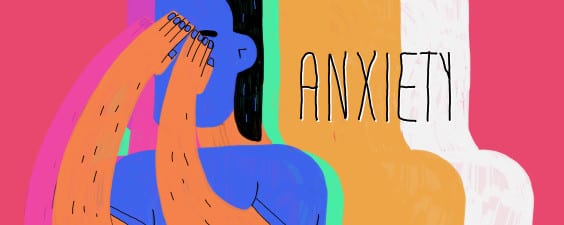15 Mar Anxiety: Training Your Brain to Disarm the Alarm

Anxiety: Training Your Brain to Disarm the Alarm
Based on data from Mindframe, a media initiative to raise awareness about mental health issues, approximately one in every five Australians will experience a mental illness, with approximately 14 % of Australians affected by an anxiety disorder in any 12-month period.
The hypothesis as to the increase in prevalence of anxiety disorders abound: from skewed work life balance, to economics, social isolation to a lack of accessible means of support. Whatever the reasons, more and more people across all age groups, socio-economic demographics and genders will, at some point in their life, experience anxiety.
What is Anxiety? Anxiety, in and of itself, is a simple threat response. The nervous system recognizes a threat, which triggers an ‘alarm’ system, which then starts a sequence of physiological reactions. These reactions serve to ready the body to either fight the threat, run from it or in some instances, freeze. The physiological events include rapid breathing and heartrate (to increase blood flow and oxygen supply to extremities), an increase of lactic acid (to flex muscles), a surge of gastric acid (to lighten the body). All of this is read by the mind as unpleasant; as it should! It is, by no means, meant to be pleasant-no alarm system in the world is- otherwise its purpose would be defeated.
What can happen, however, is that the mind can start either identifying threats where there are none, or exaggerate the severity with which a threat is perceived. Which means the ‘alarm’ is triggered with either greater frequency or severity or sometimes, both. This is when anxiety is not a proportionate, situation-specific reaction, but a disproportionate response which is often a combination of emotional features (such as fearfulness), cognitive features (which can include racing thoughts) and physiological features (for example rapid heartbeat). The entire experience can be distressing and often what can occur is a parallel process in that people who experience episodes of anxiety often develop anxiety about re-experiencing it. Which, unsurprisingly, can function to exacerbate the issue.
The first step to addressing anxiety is the recognition that the mind and body communicate with each other. That sounds basic enough, but is a small but vital fact that is very often overlooked. When anxiety is first experienced, with the physiological, emotional and cognitive features, the typical reaction is to focus attention on the mind. The belief behind this is that the mind might be able to identify the source of the ‘threat’ which triggered the anxious response and thereby either address or avoid it and thus cease the anxious feelings. However, at this time when thoughts and feelings are so heightened, trying to have a logical discussion with the mind (even if it is your own!) can serve to further increase anxiety.
Visualize trying to have a logical discussion over the ringing peal of an actual fire alarm; exhausting and futile. If you do try to engage with the mind when anxious, what happens is this: the mind and brain are in a heightened state with thoughts speeded up (thus, the term ‘racing thoughts’) and is therefore unable to fully engage in discussions that are rational. In the meantime, the body remains escalated. The mind/brain registers this escalated state as a continued need for neurochemicals and hormones that increase the stress response, which it then pumps the body with. Which causes a further increase in the anxiety response and so on, ad nauseum.
There are certain strategies that can help to mitigate the severity of anxiety and if used consistently can serve to reduce the frequency of episodes or periods of anxious feelings and thoughts.
Preventative and Protective
If anxiety-prone, the fundamentals of self-care are vital to attend to. These are good sleep, healthy diet and regular and varied exercise. When anxious or anxiety-prone, it is easy to fall into the mind-trap of self-indulgence “I’ve had a bad day so I can have a wine/sleep late/sleep in/over eat/skip a meal” as opposed to actual self-care. As tempting as it might be to polish off a slab of chocolate, recognize that it would be entirely unhelpful and possibly lead to increased vulnerability to anxiety. If we use the slab of chocolate as an example the following chain of events may occur:
Feeling anxious
Skipped a meal
Overindulged in chocolate later in the day
Sugar-rush causes jitteriness which the body can read as anxiety
The caffeine and sugar in the chocolate can impact sleep
The poor-quality sleep can impact mental state the next day, increasing vulnerability to stressors
And so on
Therefore, it is important to set up a sustainable diet and exercise plan and focus on sleeping well, with a set time for bed and for waking up in the morning (for helpful sleep hygiene and sleep help, see past articles on our website).
Also, remember, sleep, diet and exercise are connected: exercise is not as effective without a healthy diet. A healthy diet and exercise are excellent in maintaining good sleep. Keeping this in mind, setting up a sustainable self-care schedule around these three areas can become self-reinforcing, a pattern you want to develop and maintain.
Scan and Soften
When experiencing increased anxiety, rather than attempting to engage the mind, try shifting focus toward the body. This focus should not be effortful, concerted or aggressive. It should be a gentle shift toward slowly self-soothing the body back to a calmer state.
Start with the simpler aspects of the bodily response to anxiety: the muscles. Imagine you are scanning your body, starting with the face and moving downward.
Release the muscles of the face, particularly around the temples and ears. Lower the eyebrows to a relaxed neutral position and soften the mouth and throat. Shift the shoulders downward, as far away from the ears as possible. Slide the shoulder blades as low down the back as is comfortable. Try rolling the shoulders; moving them back and then down. Make sure the back is neutral, neither arched nor slumped. If you are sitting adjust yourself so you are sitting on or in front of your ‘sit’ bones (the pointy bones you can feel when sitting on a resistant surface), rather than behind them. Stretch the hamstrings and gently roll your ankles so the calf-muscles stretch and relax.
Then focus on your breathing. Inhale through the nose and exhale through the mouth, making sure that your focus is on making the breaths as slow and deep as possible, without ‘dragging’ the breath in (that is, tendons of the neck should not be at all visible on the inhale). Focus on the taste, smell and temperature of the air inhaled and exhaled, on the expansion of the diaphragm. Initially, the heart rate may briefly escalate, but it will quickly normalize and then slow down as you continue.
This ‘body scan’ helps by breaking the ‘circuit’ of the anxiety ‘alarm’. By sending the message of a soft and relaxed body to the brain, the brain no longer registers the need to pump the body full of anxiety creating neurochemicals and hormones. This brief period of distraction can also serve to slow the racing thoughts, so the mind is able to effectively engage.
Accepting Emotions
The experience of anxiety can be unpleasant. However, it is important not to let anxiety become overwhelming. This can be done by acknowledging that, as unpleasant as it may be, anxiety is an emotion and like any other emotion, is temporary. This recognition can function to counter some of the ‘anxious about anxiety’ traps that the mind can get caught up in.
When experiencing an episode of anxiety, it can be helpful to employ both gentle and factually positive self-talk: reminding yourself that a) the feeling of anxiety, though distressing, is not in itself a threat and that b) the feeling of anxiety, just like any other feeling, is temporary and will subside.
If this factually positive self-talk is consistently employed, it can function to stop the mind (and brain) from becoming too vigilant about anxiety and therefor reduce the severity of an anxious period.
Ask ‘What’ not ‘Why’
There is a tendency for people prone to anxiety to become focussed on the reasons or causes and place attention on the varied sources of anxiety and possible triggers. However, when experiencing an escalation of anxiety, this focus on the ‘why’ (such as “Why am I feeling like this?” or “Why do I always experience this?” or “Why doesn’t this stop?”) can cause one to plunge in to a rabbit hole of self-examination. This self-examination can then feed both negative and intrusive thoughts and set them to racing.
When feeling an escalation of anxiety, it would be more helpful at that time to instead focus on ‘what’: what helps to reduce anxiety – is it immersing myself in an absorbing activity, is it accessing support, is it active and goal oriented problem solving?
This strategy not only prevents a negative and overwhelming spiral of over-examination when the mind is least equipped to deal with it (that is, when already anxious), but can also function to increase feelings of self-efficacy and control over the anxiety.
Talk to a Professional
If anxiety is an on-going issue, which you feel is impacting your quality of life, do seek professional support. Often people attach a lot of negative meaning to seeing a psychologist. However, the simple meaning of seeing a mental health professional is that you value your mental health and want expert help in resolving issues that might be impacting it!
Author: Isham Alvi – Psychologist


Sorry, the comment form is closed at this time.